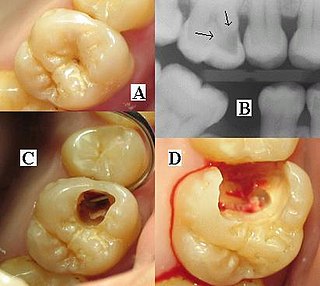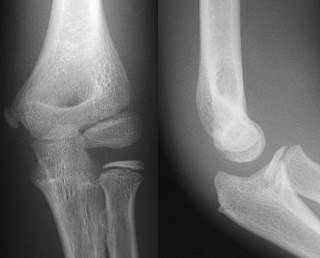Historadiography is a technique formerly utilized in the fields of histology and cellular biology to provide semiquantitative information regarding the density of a tissue sample. It is usually synonymous with microradiography. [1] This is achieved by layering a ground section of mineralized tissue (such as bone) with photographic emulsion on a glass slide and exposing the sample to a beam of X-rays. After developing the emulsion, the resulting radiograph can be viewed with a microscope. A side-by-side comparison with a slide containing radiographs of various substances of known mass can provide a rough mass estimate, and therefore a rough approximation of the concentration of calcium salts in the sample.

Histology, also microanatomy, is the branch of biology which studies the tissues of animals and plants using microscopy. It is commonly studied using a light microscope or electron microscope, the specimen having been sectioned, stained, and mounted on a microscope slide. Histological studies may be conducted using tissue culture, where live animal cells are isolated and maintained in an artificial environment for various research projects. The ability to visualize or differentially identify microscopic structures is frequently enhanced through the use of staining. Histology is one of the major preclinical subjects in medical school. Medical students are expected to be familiar with the morphological features and function of all cells and tissues of the human body from an early stage of their studies, so histology often stretches over several semesters.

A microscope is an instrument used to see objects that are too small to be seen by the naked eye. Microscopy is the science of investigating small objects and structures using such an instrument. Microscopic means invisible to the eye unless aided by a microscope.
Historadiography has also been used to visualize staining of tissue, such as spinal cord samples with thorotrast, which contains thorium that is opaque to X-rays. [2]

The spinal cord is a long, thin, tubular structure made up of nervous tissue, that extends from the medulla oblongata in the brainstem to the lumbar region of the vertebral column. It encloses the central canal of the spinal cord that contains cerebrospinal fluid. The brain and spinal cord together make up the central nervous system (CNS). In humans, the spinal cord begins at the occipital bone where it passes through the foramen magnum, and meets and enters the spinal canal at the beginning of the cervical vertebrae. The spinal cord extends down to between the first and second lumbar vertebrae where it ends. The enclosing bony vertebral column protects the relatively shorter spinal cord. It is around 45 cm (18 in) in men and around 43 cm (17 in) long in women. Also, the spinal cord has a varying width, ranging from 13 mm thick in the cervical and lumbar regions to 6.4 mm thick in the thoracic area.

Thorotrast is a suspension containing particles of the radioactive compound thorium dioxide, ThO2, that was used as a radiocontrast agent in medical radiography in the 1930s and 1940s. Use in some countries, such as the U.S., continued into the 1950s.

Thorium is a weakly radioactive metallic chemical element with symbol Th and atomic number 90. Thorium is silvery and tarnishes black when it is exposed to air, forming thorium dioxide; it is moderately hard, malleable, and has a high melting point. Thorium is an electropositive actinide whose chemistry is dominated by the +4 oxidation state; it is quite reactive and can ignite in air when finely divided.
Over recent decades researchers have generally lost interest in historadiography. The most recent publication using the term (1998) to be indexed in PubMed [3] referred to autoradiography of tritium incorporated in thymidine. [4]

PubMed is a free search engine accessing primarily the MEDLINE database of references and abstracts on life sciences and biomedical topics. The United States National Library of Medicine (NLM) at the National Institutes of Health maintains the database as part of the Entrez system of information retrieval.

Tritium is a radioactive isotope of hydrogen. The nucleus of tritium contains one proton and two neutrons, whereas the nucleus of protium contains one proton and no neutrons. Naturally occurring tritium is extremely rare on Earth, where trace amounts are formed by the interaction of the atmosphere with cosmic rays. It can be produced by irradiating lithium metal or lithium-bearing ceramic pebbles in a nuclear reactor. Tritium is used as a radioactive tracer, in radioluminescent light sources for watches and instruments, and, along with deuterium, as a fuel for nuclear fusion reactions with applications in energy generation and weapons. The name of this isotope is derived from Greek, Modern τρίτος (trítos), meaning 'third'.

Thymidine is a pyrimidine deoxynucleoside. Deoxythymidine is the DNA nucleoside T, which pairs with deoxyadenosine (A) in double-stranded DNA. In cell biology it is used to synchronize the cells in G1/early S phase.










